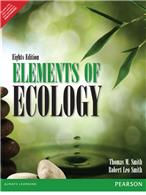Elements of Ecology

|
Author(s):
Author:
Thomas Smith
- ISBN:9789332536692
- 10 Digit ISBN:9332536694
-
Price:Rs. 1310.00
- Pages:688
- Imprint:Pearson Education
- Binding:Paperback
- Status:Available
-
|
Known for its evolution theme and strong coverage of the relevance of ecology to everyday life and the human impact on ecosystems, the thoroughly revised Eighth Edition features refined quantitative exercises, a restructured chapter on life history, a thoroughly revised species interactions unit including a chapter introducing the subject, and a new chapter on species interactions.
To emphasize the dynamic and experimental nature of ecology, each chapter draws upon current research in the various fields of ecology while providing accessible examples that help students understand species natural history, specific ecosystems, the process of science, and ecological patterns at both an evolutionary and demographic scale.
Table of Content
1. The Nature of Ecology
I. THE PHYSICAL ENVIRONMENT
2. Climate
3. The Aquatic Environment
4. The Terrestrial Environment
II. THE ORGANISM AND ITS ENVIRONMENT
5. Ecological Genetics: Adaptation and Natural Selection
6. Plant Adaptations to the Environment
7. Animal Adaptations to the Environment
III. POPULATIONS
8. Properties of Populations
9. Population Growth
10. Life History
11. Intraspecific Population Regulation
12. Metapopulations
IV. SPECIES INTERACTIONS
13. Species Interactions, Population Dynamics and Natural Selection
14. Interspecific Competition
15. Predation
16. Parasitism and Mutualism
V. COMMUNITY ECOLOGY
17. Community Structure
18. Factors Influencing the Structure of Communities
19. Community Dynamics
20. Landscape Ecology
VI. ECOSYSTEM ECOLOGY
21. Ecosystem Energetics
22. Decomposition and Nutrient Cycling
23. Biogeochemical Cycles
VII. BIOGEOGRAPHICAL ECOLOGY
24. Terrestrial Ecosystems
25. Coastal and Wetland Ecosystems
26. Land-Water Margins
27. Large-scale Patterns of Biological Diversity
VIII. HUMAN ECOLOGY
28. Population Growth, Resource Use, and Sustainability
29 Global Climate Change
|
Salient Features
• Interpreting Ecological Data exercises help students test their understanding of graphs and data and to consider different outcomes.
• Quantifying Ecology boxes help students develop the quantitative skills they need to interpret ecological data, research, and models. Skills are reinforced by a set of follow-up questions and links to GRAPHit! and QUANTIFYit! on the companion website (www.ecologyplace.com).
• Field Studies discuss ecological research performed by young up-and-coming scientists, and challenge students to interpret the results of the featured research.
• Ecological Issues essays describe how humans influence the study of ecology. For example, the short essay "The Ecology of Antibiotic Resistance" discusses how antibiotic resistance is a result of natural selection. Each essay is followed by a set of critical thinking questions.
• Engaging introductions give students a "big picture" overview of the coming chapters in each of the eight parts of the book, so they can understand how various topics interrelate.
• Landscape Ecology chapter explores the role of disturbance in ecosystems.
|
|
|
|
|